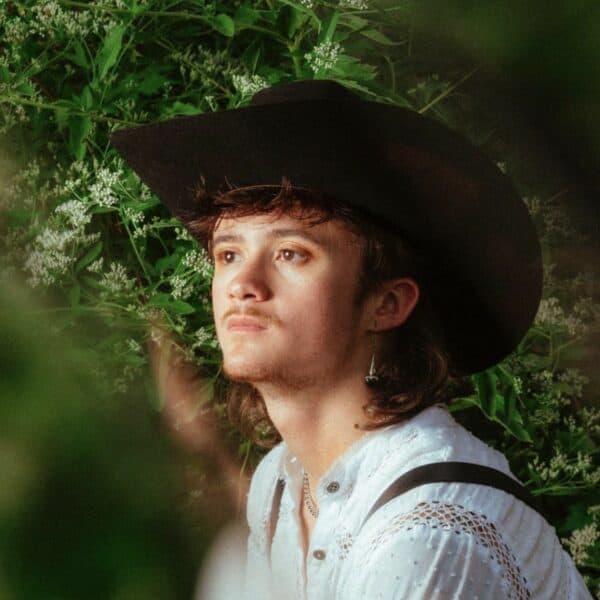(Above: William Wetmore Story: Sappho, 1867. Marble. Crystal Bridges Museum of American Art. Photo by Mud)
Only five hours from Memphis, Bentonville, Arkansas is a surprising sanctuary for fine art in the Southeast. Perhaps the best known spot I visited is the Crystal Bridges Museum of American Art, which lies on 120 acres of beautiful forest in the foothills of the Ozark mountains. The museum is a cultural site that not only emphasizes the visual arts, but also architecture, outdoor recreation, and culinary arts. Bentonville itself has over 140 miles of mountain biking trails and over 40 miles of walking trails. A six minute drive away is The Momentary, Crystal Bridges’ satellite contemporary art space. The Momentary is also accessible via shuttle from Crystal Bridges, or a short two mile walk down the Razorback Regional Greenway. Visitors of The Momentary can expect to see contemporary art, live music, and performance art, as well as participate in culinary and fine art workshops and community celebrations. The Momentary is also home to an artist-in-residence program. Both Crystal Bridges and the Momentary are free admission by the generosity of the Walton family, for the exception of the museums’ special rotating exhibitions. In addition to Crystal Bridges and The Momentary, Bentonville is home to a 21c Museum Hotel, a member of the upscale 21c hotel chain offering an expansive collection of contemporary artworks and a highly-inspired upscale restaurant, The Hive. While planning my trip, I reached out to local artist and Northwest Arkansas native, Joel Parsons, for advice on crafting the perfect art weekend. With his helpful suggestions, I formulated a plan that ensured I could taste a little of what the region has to offer.
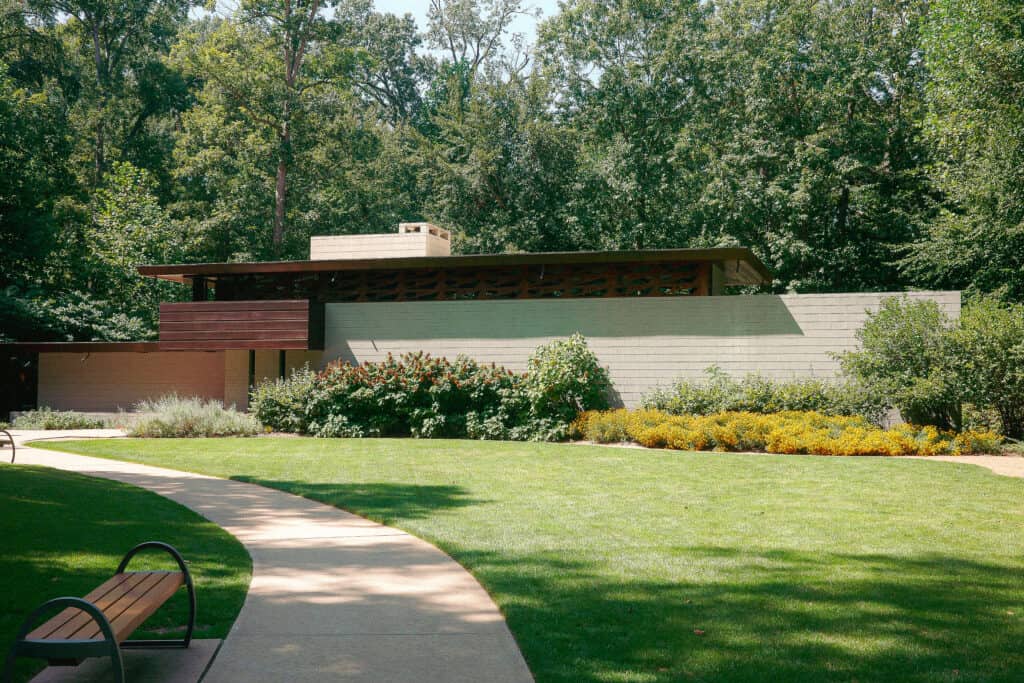
Frank Lloyd Wright: The Bachman-Wilson House, 1956.
Crystal Bridges Museum. Photo by Drew Stanford
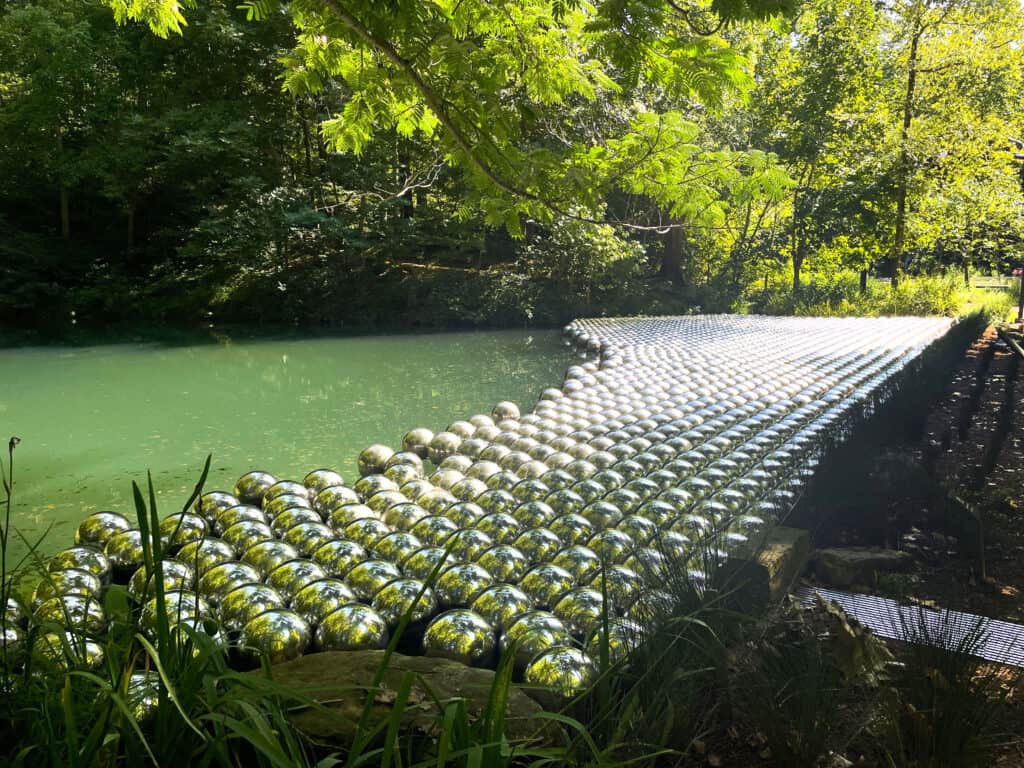
Yayoi Kusama: Narcissus Garden, 1966-present. Stainless steel spheres. Crystal Bridges Museum. Photo by Mud
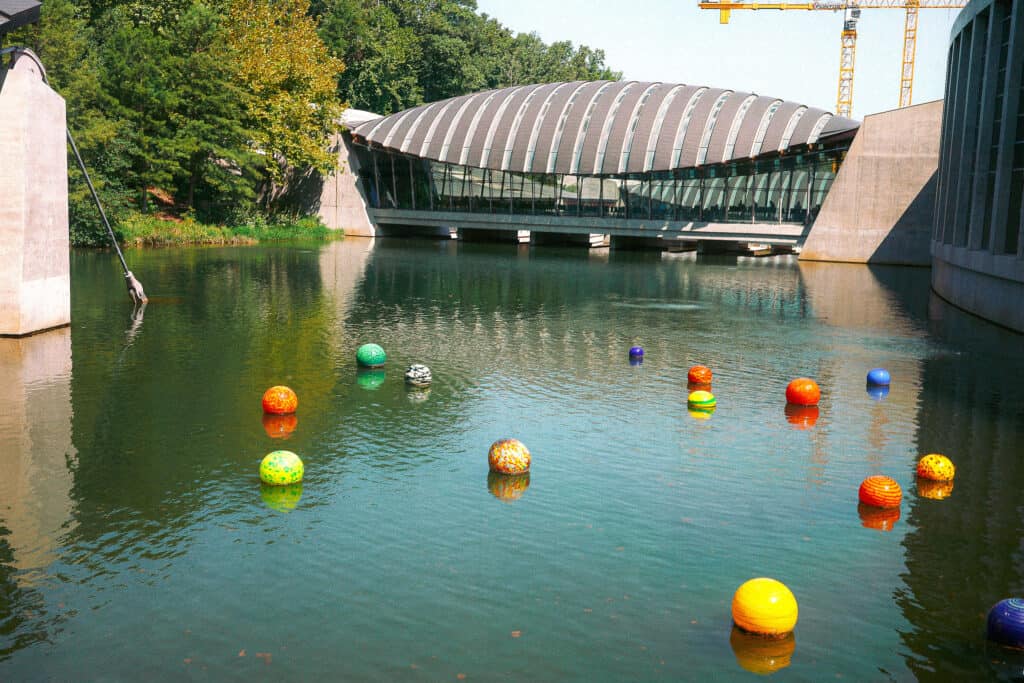
View from the nature trail at Crystal Bridges Museum of American Art. Photo by Drew Stanford
Upon arriving in Bentonville, I advise parking in the town square. I parked in the lot behind the 21c Museum Hotel, a spot I knew I would be visiting after my museum trip. From there, I suggest heading towards the forest and taking the Crystal Bridges trail to the Art Trail, entering the museum from the South Entrance. Along the trail, you will encounter one of James Turrell’s Skyspaces. The Skyspace, The Way of Color (2009), is a large round structure protruding from a hillside on the campus grounds. While walking through the doorway of the sculpture, the perception of space seems surreal; the curved stone walls create a sense of confinement, while the circular opening at the top of the structure exposes an intimate peek into the atmosphere. If you have the opportunity to witness the work at sunrise or sunset, you will be captivated by how Turrell uses LED lighting to manipulate your sense of light, space, and nature. Continuing down the path, you will cross many creeks and waterfalls. I recommend wearing good walking shoes as there is some elevation change, though the Crystal Bridges Trail and Art Trail are both ADA accessible. While approaching the south entrance, you will pass some well-known artworks, such as Louise Bourgeois’s Maman (1999), Yayoi Kusama’s Narcissus Garden (1966-present), and a corten steel rendition of Robert Indiana’s LOVE sculpture (1966-1999)1. Situated to the right of the South Entrance is Frank Lloyd Wright’s Bachman- Wilson House. Moshe Safdie, the architect of Crystal Bridges, shared Wright’s sentiment that architecture should be responsive to its environment, designing the museum with respect to the Ozarks. Embracing horizontality, both Safdie and Wright examine the landscape’s potential to heighten the architecture and vice versa. More information about the history of the Bachman- Wilson house is available in the Great Hall Corridor following the south entrance, as well as a wonderful view of the building through the museum’s expansive glass walls.
Crystal Bridges’ Temporary Exhibition Gallery was closed during my visit, so I instead went straight to the Early American Art galleries. The space featured a collection of portraits from American history; however, the museum proved keenly aware of how they displayed American culture in an institutional setting. Exploring multiplicities of identity, Crystal Bridges juxtaposed traditional portraits of cis-het, rich, white men of the past with those of underrepresented groups. For instance, situated between Gilbert Stuart’s George Washington [The Constable-Hamilton Portrait] (1797) and Thomas Sully’s Colonel Samuel Boyer Davis (1819) portraits of—you guessed it—old, rich, cis-het white men, is Kehinde Wiley’s Portrait of a Florentine Nobleman (2018). Wiley’s painting depicts a portrait of Shontay Haynes, a St. Louis local, in front of and intertwined with an ornate sixteenth-century floral background. Wiley’s paintings place Black individuals in the historical context of portraiture, calling attention to the identities that have been left out of history. By sandwiching Wiley’s work between two classical paintings of prominent American figures, Crystal Bridges is acknowledging and contributing to the mission of unveiling history and uplifting voices that have historically been silenced. On your way out of the Early American gallery, be sure to spend some time with William Wetmore Story’s life-size marble sculpture Sappho (1867). The work is representative of American and European interest in classical subjects and mythologies, though Story was likely unaware he was depicting a future prominent figure in LGBTQ+ history and literature, whose poems are heavily coded with feminine desire2.
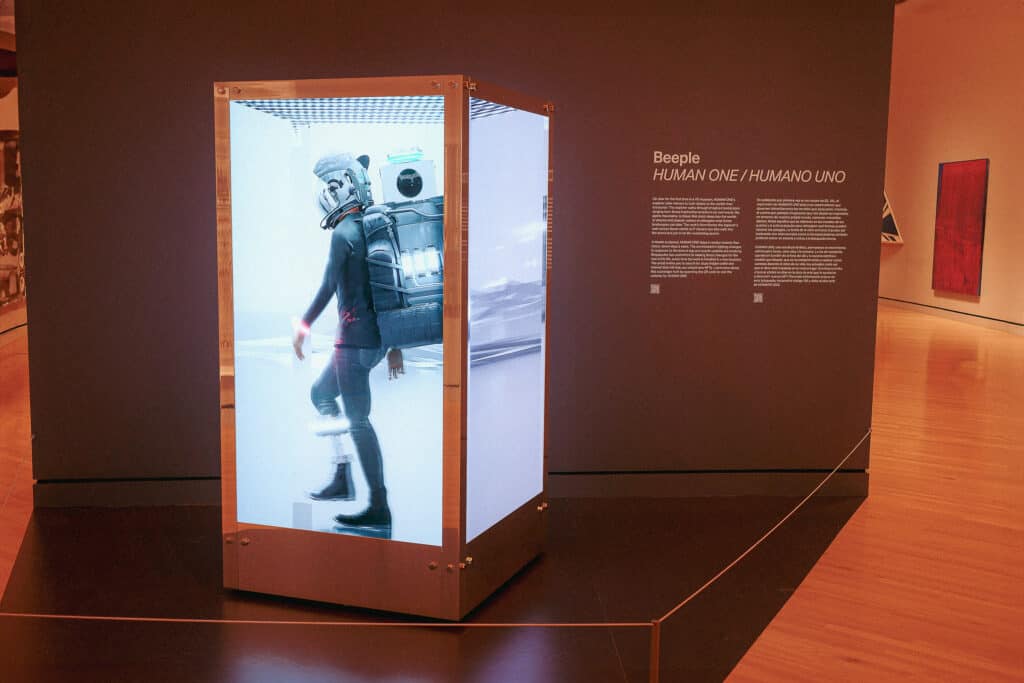
Beeple: HUMAN ONE, 2021. Four screen video.
Crystal Bridges Museum. Photo by Drew Stanford
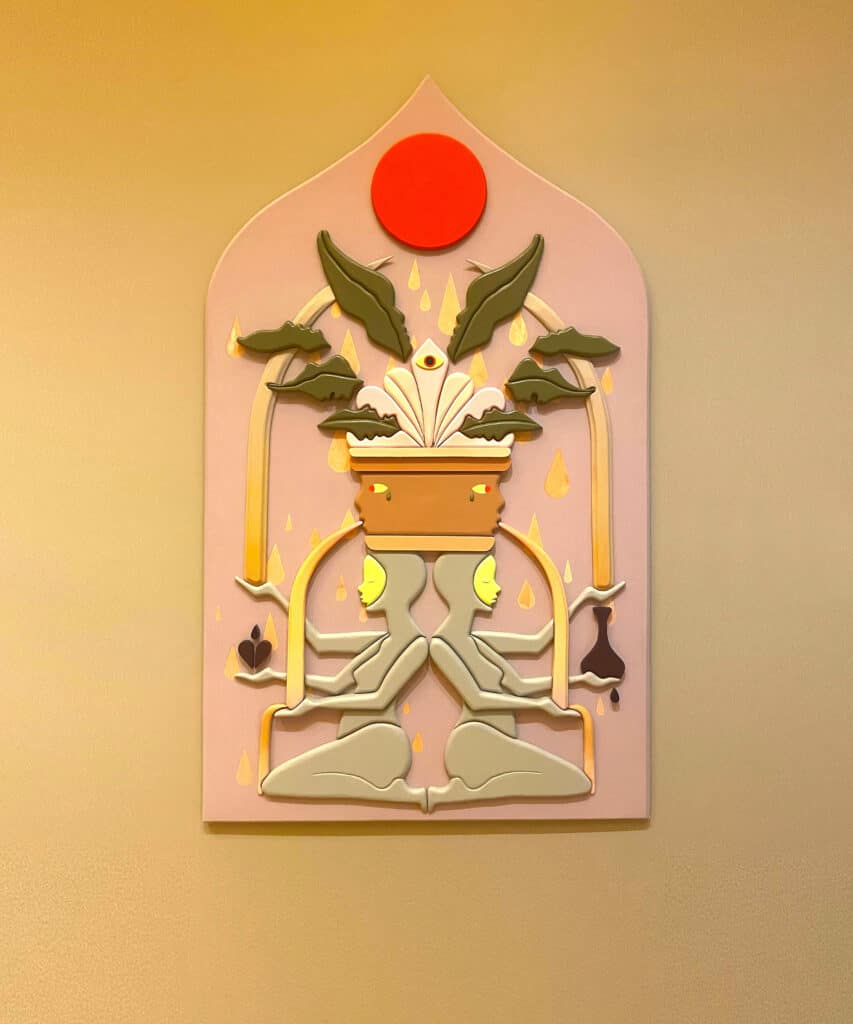
Mae Aur: The Guardeners, 2019. Hand cut wood, acrylic paint. Crystal Bridges Museum. Photo by Mud
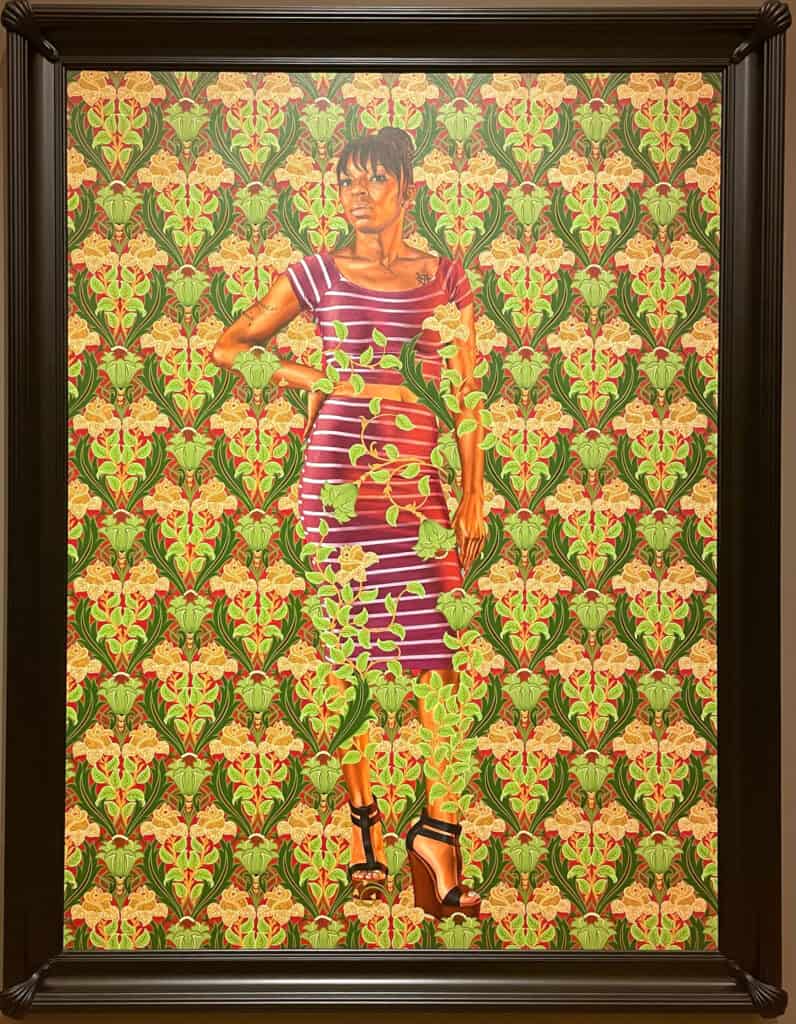
Kehinde Wiley: Portrait of a Florentine Nobleman, 2018. Oil on linen. Crystal Bridges Museum. Photo by Mud
Following the Early American and Modern Art galleries is the Contemporary Art gallery. While the previous galleries were more-or-less organized chronologically, the contemporary gallery arranged work by theme. As soon as I entered the gallery, I was greeted by Beeple’s HUMAN ONE sculpture. The work is a technologically advanced, spinning mechanism that portrays a distorted astronaut traversing an electric, surreal, and ever- changing landscape. The work commands full attention of the room with its intense light and color. Opposite HUMAN ONE are two paintings by Mark Rothko and Lee Krasner, respectively. Rothko and Krasner were members of the Abstract Expressionist movement of the 1940s and 50s, a period of painting known for grandeur, but also existentialism caused from the upheavals of World War II. In post-World War II America, these two paintings would have demanded the same level of investigation as Beeple’s HUMAN ONE. By situating examples of contemporary work from opposite ends of the timeline, Crystal Bridges emphasized how rapid documentation of culture has shifted with the introduction of new technologies. I sat with Lorraine O’Grady’s Untitled (Mlle Bourgeoise Noire) for a long while. The series of photographs documented O’Gradys performance work in which she entered art institutions, unannounced, dressed as her fictional pageant queer persona Mademoiselle Bourgeoise Noire (Miss Black Middle-Class). By invading art spaces adorned in a dress and cape constructed of 180 pairs of white gloves and lashing herself with a whip as she recited poems, O’Grady gave the institutions a “piece of her mind” and insisted on acknowledging the exclusion of underrepresented communities and internalized oppression3. Investigating the documentation of O’Grady’s performance art as individual photos that capture a duration of time gave me perspective on how witnessing a live event can hold the same integrity as how it is seen post-performance. Sitting with this piece put me in a prime headspace for my nighttime event, Matty Davis’ Die No Die (Arkansas) hosted at The Momentary. As I wrapped up my adventure in the contemporary art gallery, I recognized the Memphis native Mae Aur had a work in the gallery. Seeing their work, The Guardeners, in the Crystal Bridges permanent collection made me elated with respect and pride for my lovely art community back home in Memphis.
The Momentary is an interdisciplinary art space focusing on music, visual art, performance art, culinary art, and film. Matty Davis’ performance Die No Die included previously mailed zines functioning as maps, an 800 meter procession, lighting effects, choreography, and spoken word. While witnessing the work, I had the response of most performance art viewers, “What did I just see, and why did it make so much sense?” As a performance artist myself with limited access to viewing live performance art, it was an interesting opportunity to witness such an event in a large institution. I returned to the Momentary the following day to view the galleries. Exhibitions by Dave Cole, Firelei Báez, Will Rawls, Yvette Mayorga–an artist- in-residence–and Rumwolf were on view. All of the galleries shared common threads: historical context, exploration of identity, and specific art mediums displayed as installation. Firelei Báez’s installation To Breathe Full and Free: A Declaration, A Re- visioning, A Correction, utilized shadowplay and set construction to explore various cultural narratives. While the majority of the exhibition comprised grand sculpture amplifying the gallery space, Báez considered all of her work to belong to “the illusionistic realm of painting.” Mayorga’s exhibition contained both sculptures and paintings; however, the treatment of the gallery space created synergy between the mediums. Checkered patterns were laid in complementary sections. Towards the far end of the gallery, the floor became checkered carpet. The moment my feet felt the softness of the ground, I completely melted into the work. I was living in Mayorga’s world. The treatment of the gallery space became integral to her work, and the other artists embraced this method too.
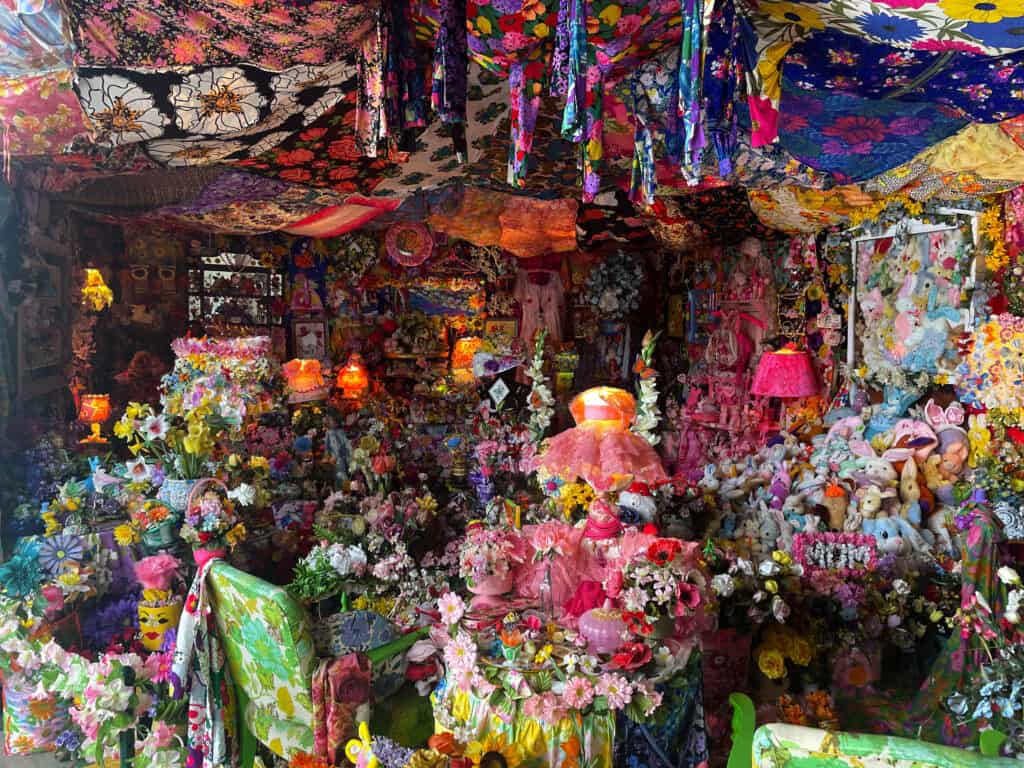
Portia Munsion: The Garden, 1996-2019.
21c Museum Hotel in Bentonville, AR. Photo by Mud

Cocktail from The Hive at the 21c Museum Hotel.
Photo by Mud
In addition to visual art viewing, I indulged in the culinary arts. The Momentary houses an Onyx Coffee Lab, though it was temporarily closed during my trip. Luckily, I was able to visit another Onyx location down the street and had the best coffee of my life. I also paid a quick visit to 21c Museum Hotel to view their expansive contemporary art collection and enjoy a cocktail at The Hive. I was particularly excited to try “The Garden,” a vodka drink inspired by Portia Munson’s current installation, The Garden (1996-2019) which was on view in the hotel’s lobby.
A significant part of my personal agenda is to uplift Southern artists. We are underrepresented in the “Capital A” art world. Having a thriving art scene only 5 hours from home fosters hope that my community can take ownership in the art world without living in New York, Chicago, or Los Angeles. Crystal Bridges, The Momentary, and 21c inspire a cross- disciplinary art scene despite residing outside of a major metropolitan area. Bentonville, Arkansas has plenty to offer and contribute to the larger conversation of artistic cultural documentation. Take time to visit, but, more importantly, take time to witness. There are moments in the galleries where time seems to stand still.
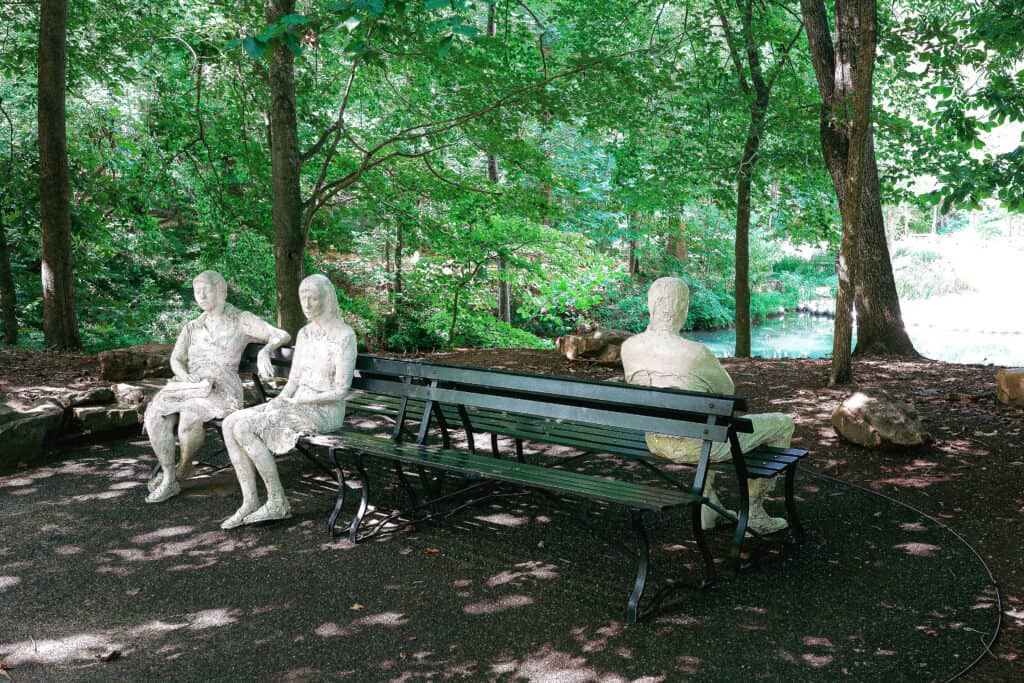
Bachman-Wilson House at Crystal Bridges Museum. Photo by Drew Stanford.
REFERENCES
- Infinity Mirrored Room- My Heart is Dancing into the Universe by Yayoi Kusama can also been seen in Crystal Bridges’ contemporary art gallery
- Sappho is from the island of Lesbos, hence the term “lesbian.”
- Object label for Untitled by Lorraine O’Grady. At the Crystal Bridges Art Museum, Bentonville, Arkansas. Seen on: August 5, 2023.

